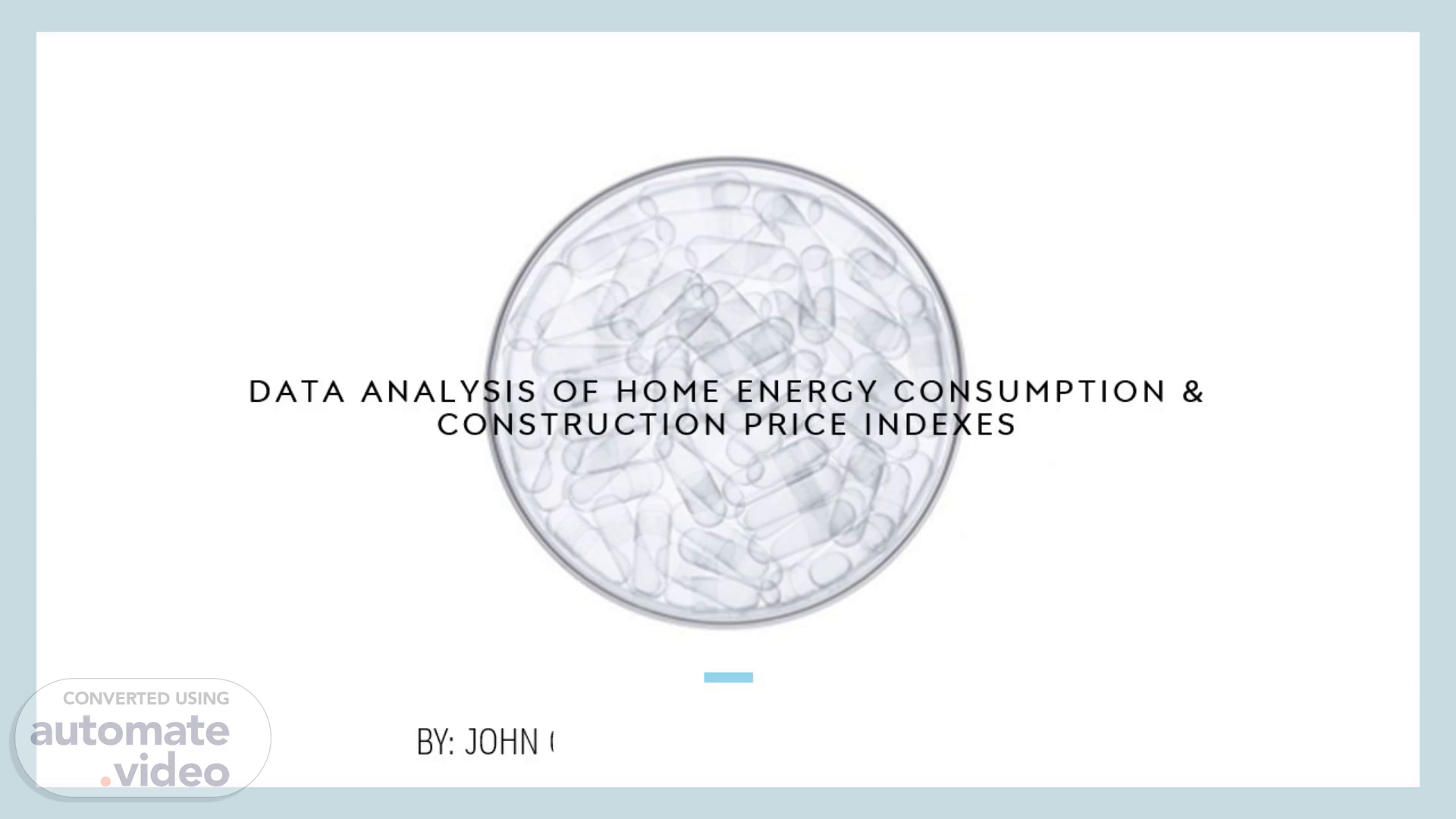
Data Analysis of Home Energy consumption & construction price indexes
Scene 1 (0s)
Data Analysis of Home Energy consumption & construction price indexes.
Scene 2 (9s)
[Audio] "In this presentation, we'll be exploring two key datasets: Home Energy Consumption and Construction Price Indexes. We'll analyze the structure, entities, and attributes within each dataset. Our goal is to understand the relationships between different data points and apply them to answer important questions. We'll also identify both the advantages and disadvantages of these datasets and suggest some potential applications.".
Scene 3 (54s)
[Audio] "The first dataset we'll examine is Home Energy Consumption. This data comes from data.world, and it's available as a C-S-V file. It contains 20 entities and a total of 2520 attributes. The dataset tracks household energy consumption, including electricity and gas usage, across various households and time periods. It includes details on energy consumption, costs, and even factors like weather conditions, making it useful for understanding seasonal energy trends.".
Scene 4 (2m 5s)
[Audio] "This dataset offers several advantages. It provides detailed insights into how households use energy and allows us to identify trends, such as how weather impacts energy consumption. However, one challenge is that data for certain periods may be incomplete. Additionally, variations in regional energy sources can lead to discrepancies in the data, making it harder to compare across locations.".
Scene 5 (2m 51s)
Dataset 2-Contruction Price Indexes. Data Source: Excel file with supporting attachments based on Construction Price Indexes from data.world. Location for Download: https://data.world/finance/construction-price-indexes Entities and Attributes: 2 Excel documents with a total of 91 Entities and 7180 Attributes. Description: Details construction materials and services prices across various project types and geographic locations. Entities: Materials (lumber, steel), construction project types (residential, commercial), geographical regions. Attributes: Pricing data, timelines, cost trends..
Scene 6 (3m 29s)
Data relationships and structure. Home Energy Consumption: Relationships exist between households, energy usage, costs, and weather conditions, allowing for the analysis of external impacts on consumption. Construction Price Indexes: The dataset allows for the comparison of material prices across different regions and time periods, highlighting how economic factors affect construction costs..
Scene 7 (4m 1s)
Dataset 2 - Analysis. Advantages: Offers detailed data on cost trends for materials, useful for forecasting and budgeting. Disadvantages: The dataset is complex due to the large number of attributes, making it difficult to isolate the impact of single factors..
Scene 8 (4m 32s)
Data Examples. ts•q grn 0 uxn vu K'.tu unti O tun imu Erna ngq {"u O ttttfi trtt vsu 'üttt t tttSKt t-wa tggttt Æ my Elnsn mnn uri€n 1-wa titut umn *utt ntt 0 t ttßtg nn tw,n msn.
Scene 9 (5m 5s)
Questions for Analysis. Home Energy Consumption Dataset: What are the seasonal trends in household energy usage, and how do they vary across different regions? How does the type of energy source (electricity vs. gas) affect the overall energy expenditure of households? Construction Price Indexes Dataset: How have the prices of key construction materials changed over the last five years? What is the impact of regional differences on construction costs, and how can this data help predict future trends in construction pricing?.
Scene 10 (5m 50s)
Answers to Key questions. Seasonal Trends in Home Energy Consumption: Analysis of the dataset shows that energy consumption typically spikes during colder months due to heating requirements, especially in regions where gas is the primary energy source. In warmer months, electricity usage rises due to increased cooling demands. Regions with milder climates exhibit less pronounced seasonal fluctuations. Impact of Energy Source on Expenditure: Households using gas for heating tend to see lower overall costs during the winter compared to those relying solely on electricity. However, electricity costs dominate in the summer when cooling needs rise. The dataset reveals that energy-efficient households typically spend less year-round by balancing electricity and gas usage. Trends in Construction Material Prices: Over the past five years, lumber prices have seen significant fluctuations driven by supply chain disruptions and economic factors. On the other hand, steel prices have been more stable but still impacted by global market trends. The dataset indicates that material costs can vary significantly by region, with urban areas experiencing higher price hikes than rural regions. Impact of Regional Differences on Construction Costs: The dataset shows that construction costs are higher in densely populated areas, where demand for materials is greater. Regions prone to natural disasters also see higher material prices due to increased demand for rebuilding. This data can help predict future construction costs, especially in areas experiencing population growth or economic development..
Scene 11 (8m 10s)
Conclusion. In conclusion, both datasets offer valuable insights into their respective areas. Household energy consumption and construction pricing. By understanding the entities, attributes, and relationships within these datasets, we can extract actionable insights, predict trends, and make data-driven decisions that benefit industries and consumers alike..
Scene 12 (8m 44s)
Thank you. [image] Bacteria cultured in a petri dish for a laboratory or a scientific investigation.